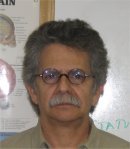|
Plenary Lecture
Epileptic Seizures: Quakes of the Brain?

Professor Ivan Osorio
Co-authors: Mark G. Frei, Didier Sornette, John Milton
Department of Neurology, The University of Kansas Medical Center, Kansas City,
KS
USA
E-mail: iosorio@kumc.edu
Abstract: Earthquakes, hurricanes, landslides, financial crashes, and
epileptic seizures are catastrophic events thought to exhibit similar
self-organized behavior found in complex systems. The proposed analogy is
based on statistical similarities, such as a power law distribution of event
sizes, and on common structures in terms of coupled threshold oscillators of
relaxation. But, beyond the analogies, what can we learn from them and how can
this knowledge be used to advance each relevant discipline? Here we
demonstrate a striking correspondence between seizures (SZ) and Southern
California earthquakes (EQ), extending over seven statistics which exhibit
remarkably robust scale-free properties: The Gutenberg-Richter distribution of
event sizes, the Omori law, the inverse Omori law of foreshock rates, and the
conditional distribution of inter-event times, among others. Then, based on a
theoretical framework developed for EQ and using an animal model of epilepsy,
we verify the prediction that increased neuronal coupling leads to
synchronized SZ behavior with characteristic SZ size and time scale.
Translating back from SZ to EQ, the proposed analogy, informed by the ratsí
results, suggest that characteristic EQ behavior, proposed based on
controversial observations, should be a genuine class of dynamics in relevant
seismo-tectonic settings characterized by strong coupling and low crust
heterogeneity. Taken in their totality, the SZ-EQ equivalencies explain the
wide range of SZ energies, the existence of metastable epileptic states (from
SOC to quasiperiodicity), memory, and their inherent self-triggering capacity.
They also point to a general strategy for forecasting SZ capitalizing on the
mechanism that future events are in part triggered by past events. While this
mechanism is the basis of time-dependent EQ forecasts, the implications for SZ
remain to be exploited. This approach may bring us closer to one of
neurosciencesí grails: prediction and prevention of SZ.
Brief
Biography of the speaker:
Ivan Osorio is a Professor of Neurology at the UNiversity of
Kansas Medical Center and Visiting Scientist at the Dept. of Mathematics,
Havey Mudd College, Claremont, Ca. He is a graduate of the Universidad del
Valle School of Medicine. He applies mathematical tools and a systems approach
to the study of epilepsy, a dynamical disease, with cyclic but aperiodic
manifestations. The group which he leads demonstrated the feasibility and
safety of seizure control using high frequency electrical currents, triggered
by the automated real-time detection of non-stationary signals changes. His
collaboration with Professor D. Sornette from ETHZ has led to the uncovering
of dynamcial similarities between epileptic seziures in human and animals and
earthquakes.
|